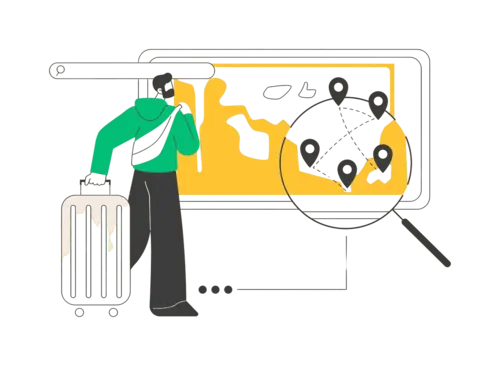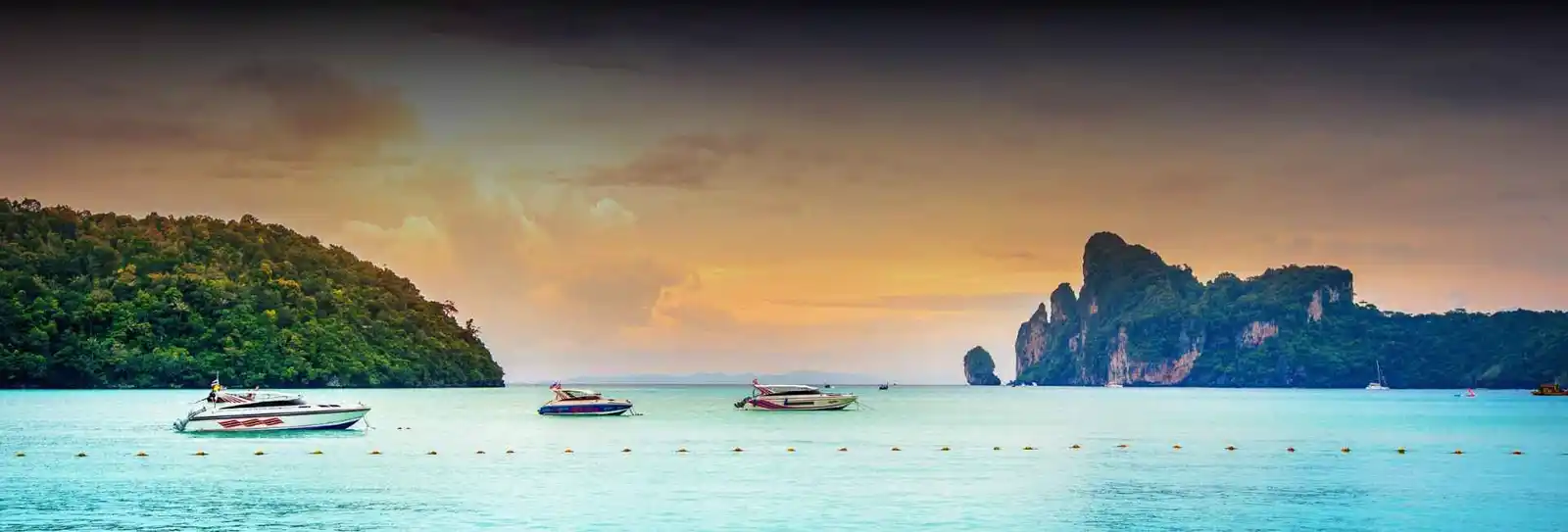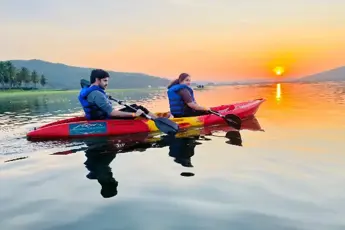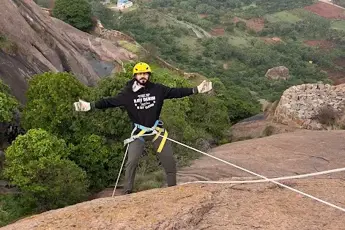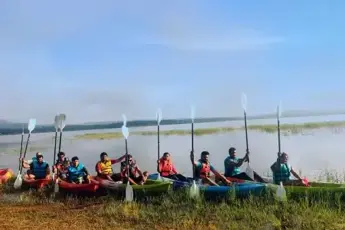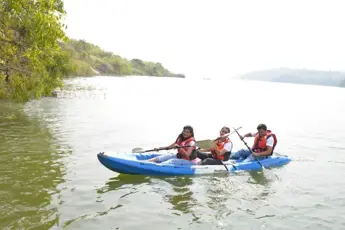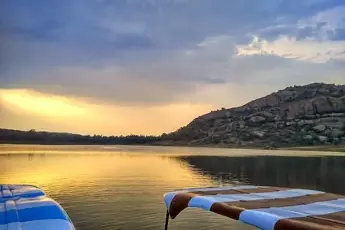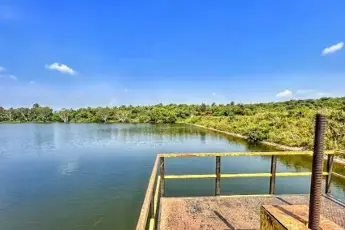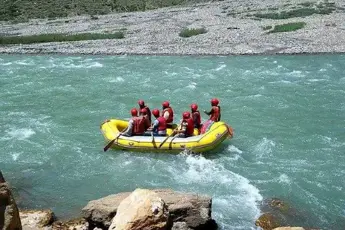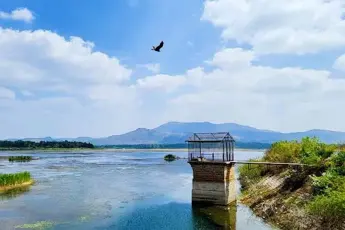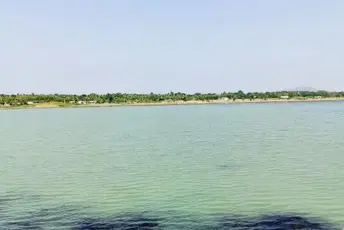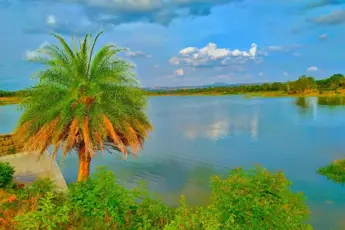
In the calm, rocky place near Magadi in Ramanagara, Karnataka, the Y.G. Gudde Dam, also called Y.G. Gudda Reservoir, is a new water work made to help with water for drinking and to help the country area grow. It sits by hard granite-gneiss rocks and farmland. This dam holds the monsoon water from the local area, making it key for saving water there. The main goal of Y.G. Gudde Dam is to give a steady flow of clean water for drinking to small villages as part of the Jaljeevan Mission. The work aims to help many people in Ramanagara and Magadi towns with a water plan for many places. Set to help about 87,000 homes, the dam is a big move to deal with not having enough water and to make sure water is there for a long time for over 3.6 lakh folks. Made with a DBOT (Design–Build–Operate–Transfer) plan, the dam mixes new building ways with care for local nature. It sits high at about 620–675 meters up and gets a lot of rain each year, over 930 mm, which makes it good for holding water. The land around has deep red and clay soils that help grow many crops like ragi, rice, sugar cane, seeds, coconut, mango, and mulberry, so the dam also helps with growing food. The place and rock stuff around the dam make it both a smart and nature-friendly work. To finish within 15 months of its okay, Y.G. Gudde Dam is set to be a key help for the nearby villages, making water easy to get, helping health in rural areas, and adding to ongoing growth there.History of Y.G. Gudde DamThe Y.G. Gudde Dam in Ramanagara is set near the lovely lands near Magadi. It was made to help meet the water needs of the area's small towns. Unlike other dams built only for crops or power, this dam, made in the 21st century, aims to deal with the lack of drinking water in dry parts of Karnataka. Ramanagara, known for its pretty views and granite hills, always had trouble getting good and steady water. The hard ground made it tough to get water from under the earth. The rain was not sure and didn't help, mainly in places like Magadi and Channapatna, where farm work and daily life relied on the rain. As far back as the 1990s and 2000s, local groups and councils stressed how much the area needed a good and big water park. There were small lakes and man-made spots, but not enough for more people. Many villages used tank water or open water spots, which dried up when it was hot. Talk of a big water spot started around 2010–2015. State folks and experts in many fields picked the place for a new water store that would be used just for drinking water. Y.G. Gudde was a good spot due to its water area, right ground type, and it was not too far from places that needed water. The dam's land gets a good bit of rain every year, and its shape helps gather rainwater. Also, not many people lived there, so getting the land was easier than in places with lots of people. By the late 2010s, the state of Karnataka checked if the dam plan would work well and what effects it would have. It wanted to make sure the dam would help now and in the future, until the year 2053, and help many villages. This plan matched the national plan to get water taps to all rural houses.In 2024, the state leaders said yes to building the Y.G. Gudde Dam and other water plans. The project would cost ₹155 crore and help many villages in Ramanagara and Magadi. The plan to make and keep the dam included a partner who would build, use, and look after it for some time. Work on the dam began early in 2024. It was to be a strong dam that could handle rainy times and keep enough water for dry months. The plans for the dam, which used good concrete and stone, stayed with the state. The dam's water area would join with a full set of water pipes, cleaning spots, and water pushing places to make sure clean water got to far towns. The plan was not to hurt nature much and to set up a system that was good for the people living there. Plans included solar spots, water-saving spots, and dirt control steps. Although new, the dam is seen as a big change in how the state plans, moving from big farm-focused dams to small, people-focused ones made for important needs like drinking water. Before, the Magadi area mainly grew crops with rainwater, like ragi and rice, which often did not do well without enough water. The Y.G. Gudde Dam should help stop water problems, make growing crops steadier, and let people grow different plants. Also, having clean drinking water should mean fewer health issues from bad water. Women and kids, who used to go far to get water, will have more time for school, work, and other things.As of mid-2025, although still being built, the Y.G. Gudde Dam is already a good example for other water plans in Karnataka and other places. With its careful design and big effects on society, the dam marks a new step in building needed things for small places. The worth of the Y.G. Gudde Dam will be seen not just in how much water it holds, but in how it changes lives. It stands as a mark of planning with the people in mind, quick government action, and growing in a way that lasts, in a state that really needs to watch its water. As the dam finishes, it keeps giving hope and strength to the people there a sign of safety in uncertain times and a start for better lives for many years ahead.Nearby Places around Y.G. Gudde DamMagadi Town: Right by Y.G. Gudde Dam, Magadi is full of history from Kempegowda, who set up Bengaluru. It has old places like Ranganathaswamy Temple and has a calm, local feel that shows Karnataka's past and way of life. Many come for a quiet break or to see tiny towns close by.Ramanagara: About 30–35 km from the dam, Ramanagara is known for its rough hills, named "Sholay Hills" after the famous Bollywood movie Sholay was shot here. It’s great for rock climbing, bird watching, and trekking, with rocky hills and woods home to vultures and other wild birds.Savanadurga: One of the largest single rock hills in Asia, Savanadurga is around 25–30 km from Y.G. Gudde Dam. It draws those who love hiking and nature. The climb up gives great views and old ruins on the hill. There’s a temple at the foot that means a lot to many.Manchanabele Dam: Situated about 40 km away, Manchanabele Dam is a top spot for weekend trips from Bengaluru. It lies on the Arkavathi River and has lovely views, more so when it rains. People enjoy kayaking, having picnics, and taking photos here. It’s calm and pretty, perfect for nature lovers.Dodda Alada Mara (Big Banyan Tree): Near Kethohalli, about 45 km from Y.G. Gudde Dam, the Dodda Alada Mara is a 400-year-old big tree that spreads over three acres. It pulls in visitors and is great for exploring the countryside. Its wide shade offers a rare spot of natural charm and a calm place for picnics.Channapatna: Called the “Toy Town of Karnataka,” Channapatna is about 40–45 km from the dam. It’s known for its bright wooden toys and crafts, made the old way. It’s a good spot for buying gifts and seeing how they are made. The busy markets also have treats and sweets from traditional Karnataka.Thippagondanahalli Reservoir (T.G. Halli Dam): About 50 km from Y.G. Gudde Dam, the T.G. Halli Dam is a big lake that gives drinking water to parts of Bengaluru. Though not always open, the area around it has great views of the lake and woods. It’s good for a quick visit or photography, especially just after it rains.Kanakapura: Situated around 60 km from the dam, Kanakapura is noted for its riverside resorts, green zones, and walking paths. The area has lush trails, waterfalls, and nature camps, making it a top escape for those who love the outdoors. It also serves as a spot to explore other natural places like Bananthimari Betta and Kabbaladurga.Best times to visit Y.G. Gudde DamPost-Monsoon (October to February): This is the best time to visit Y.G. Gudde Dam. In these months, the water is full from the rain, and the land is green under clear grey skies, cool between 18°C and 28°C. It's good for seeing new places, taking photos, and having picnics. Bird watchers may like this time as birds come from faraway places.Monsoon (June to September): The monsoon brings a lot of rain, filling the dam and renewing the area. The sights and fog are amazing at this time, but you should watch out as paths could be slippery. It's the best time for nature fans and for those who love the pure look of rainy times.Summer (March to May): Though it gets hot, mornings and evenings are still good for short trips. The water might be less, but the dam area stays lovely. This time is less crowded, perfect for calm photos and quiet walks.How to Reach Y.G. Gudde DamBy Railway Station: Nearly 3,035 kilometres from the dam, Ramanagara Railway Station is the nearest train station. By train, Ramanagara links well with Bengaluru and Mysuru. To get to Y.G. Gudde Dam from the station, grab a taxi or get on a local bus. Magadi Road Station is also there, albeit it is not as well-linked.By Airport: About 100110 km from the dam, Kempegowda International Airport in Bengaluru is the closest airport. You can travel from there to Magadi by hailing a cab or using a taxi app, and then go to the dam. Coming by plane, it is wise to check out other neighbouring locations.By Bus: From Bengaluru and other places, State-run KSRTC buses and private companies provide buses to Magadi and Ramanagara. You can rent a cab, jeep, or autorickshaw to the dam once in Magadi. Excellent for group travel or backpacking, this approach is environmentally friendly and inexpensive.Why Book with escape2exploreWhen exploring the YG Gudde Dam from Bengaluru and beyond, escape2explore stands out as a trusted name in adventure and experiential travel. Here’s why hundreds of travellers choose us for their getaways:Trusted, Well-Reviewed Local Operator: escape2explore has gained the trust of thousands of content tourists all over India. With persistent positive feedback and an unblemished reputation for delivering quality experiences, we assure you that your experience will be hassle-free, memorable, and value-packed. Our insider local knowledge guarantees that you will always be in safe hands.Seasoned Guides: Our trips are led by friendly, trained, and professional guides who are passionate about the outdoors and your safety. Whether it's a beach trek, a cultural tour, or a spiritual walk through temples, our team knows the terrain, the stories, and how to make each moment count.Safe & Curated Itineraries: Your safety is our number one priority. Our tour packages are thoughtfully crafted with safety measures, researched accommodations, and easy travel arrangements. We take care of the details so you can have the experience hassle-free and worry-free.Unique Experience That You Won't Find Anywhere Else: With escape2explore, you discover more than the tourist attractions. We go off the beaten track with hidden beaches, unusual treks, offbeat cultural destinations, and true interactions.Read: Top 8 Treks in Uttarkhand |Best Rhododendron Treks |Trekking Travel Transformation |Trekking in India Wildlife Sancturies |First Himalayan Trek
